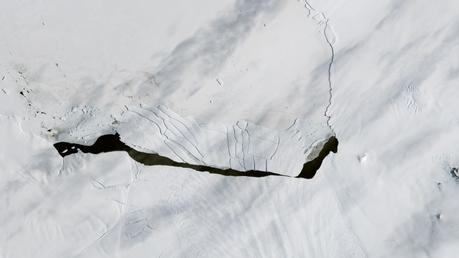 Throughout 2017 I've posted a number of stories about Antarctica's ice shelves are calving off massive chunks of ice sending icebergs adrift into the Southern Ocean. We first saw one of these events back in July, when a large section of the Larsen-C Ice Shelf broke away, creating a berg the size of Delaware. In September, a similar break-up occurred near the Pine Glacier as well. As you can imagine, these events have been watched closely by scientists, who view Antarctica as the canary in the coal mine when it comes to climate change. Now, there is even more cause for concern, as thing continue to confound and perplex researchers.
Throughout 2017 I've posted a number of stories about Antarctica's ice shelves are calving off massive chunks of ice sending icebergs adrift into the Southern Ocean. We first saw one of these events back in July, when a large section of the Larsen-C Ice Shelf broke away, creating a berg the size of Delaware. In September, a similar break-up occurred near the Pine Glacier as well. As you can imagine, these events have been watched closely by scientists, who view Antarctica as the canary in the coal mine when it comes to climate change. Now, there is even more cause for concern, as thing continue to confound and perplex researchers.Typically when a large chunk of ice breaks away from the Antarctic, it tends to float north into the Southern Ocean, where the warming waters cause it to melt and break-up over a period of years. But, that isn't what happened with the piece from the Pine Glacier, which quickly broke up into 20 smaller pieces less than a month later. That means that the ice itself is already somewhat thin and fractured, and possibly that the water around it is starting to warm up as well.
Why is this such an issue? Because the Pine Glacier is already the fastest retreating glacier on the planet, and it contains about 10% of the water in the Western Antarctic Ice Sheet. When you combine that with the nearby Thwaites Glacier, which is also shrinking rapidly, you'll find that there is enough water to raise sea levels across the globe by 11 feet (3.3 meters). That would be disastrous to millions of people around the world.
The large sections of ice that broke off from Pine Glacier and the Larsen-C Ice Shelf actually serve as a buffer between the sea and the glacier itself. With those protective buffers gone, the melting of the glaciers is only expected to accelerate. While it will take decades for them to vanish altogether, resulting in that 11-foot rise in sea levels, it won't take long for them to begin brining those levels ups couple of feet. That alone would be devastating. Throw in the fact that there are plenty of other glaciers that are adding to the increase, and you start to understand why this is such a major concern.
Unfortunately, it may be too late to do anything about it. The Byrd Research Center in Antarctica reports that average temperatures near the Pine Glacier have already risen 2ºC or 3.6ºF. That may not seem like a lot, but in a fragile ecosystem like the Antarctic, it is enough to push things past the point of no return.

